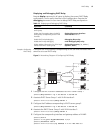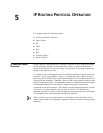
IPX Configuration 61
Packet length :60
Data offset: 10
■ Debug and trace the packets located in SYN, FIN or RST.
Operations include:
<SW8800>terminal debugging
<SW8800>debugging tcp transact
The TCP packets received or sent can be checked in real time, and the specific
packet formats are the same as those mentioned above.
IPX Configuration Internetwork Packet Exchange (IPX) protocol is a network layer protocol in the
NetWare protocol suite. It is similar to IP in the TCP/IP protocol suite. IPX functions
to address, route and forward packets.
IPX is a connectionless protocol. Though an IPX packet includes a destination IPX
address in addition to the data, there is no guarantee of successful delivery. Packet
acknowledgement and connection control must be provided by protocols above
IPX. Each IPX packet is considered an independent entity that has no logical or
sequential relationship with any other IPX packets.
IPX Address Structure IPX and IP use different address structures. An IPX address comprises two parts:
the network number and the node address; it is in the format of network.node.
A network number identifies the network where a site is located. It is four bytes
long and expressed by eight hexadecimal numbers. A node address identifies a
node on the network. Like a MAC address, it is six bytes long and written with the
bytes being separated into three 2-byte parts by “-”. The node address cannot be
a broadcast or multicast address. For example, in the IPX address bc.0-0cb-47, bc
(or 000000bc) is the network number and 0-0cb-47 (0000-00cb-0047) is the node
address. You can also write an IPX address in the form of N.H-H-H, where N is the
network number and H-H-H is the node address.
Routing Information
Protocol
IPX uses the Routing Information Protocol (RIP) to maintain and advertise dynamic
routing information. With IPX enabled, the switch exchanges routing information
with other neighbors through RIP to maintain an internetwork routing information
database (also known as a routing table) to accommodate to the network
changes. When the switch receives a packet, it looks up the routing table for the
next site and if there is any, forwards the packet. The routing information can be
configured statically or collected dynamically.
This chapter introduces RIP in IPX. For the RIP configurations on an IP network,
refer to the routing protocol section in this manual.
Service Advertising
Protocol
The Service Advertising Protocol (SAP) advertises the services provided by servers
and their addresses. It is used by IPX to maintain and advertise dynamic service
information. With SAP, a server broadcasts its services when it starts and the
termination of the services when it goes down.
With IPX enabled, the switch creates and maintains an internetwork service
information database (or the service information table) through SAP. It helps you
learn what services are available on the networks and where they are provided.


















